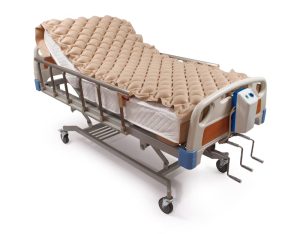 Decubitus ulcers, also known as “pressure ulcers” or “bed sores,” can result from extended pressure against the skin over bony areas. These painful wounds most commonly occur in older adults, people using wheelchairs, nursing home residents, or people under long-term hospitalization. While bed sores could lead to severe infections or other complications, patients can have a good prognosis with early detection and treatment. Today, we’ll review recognizing the warning signs of bed sores and share advice on what to do if your loved one develops a bed sore.
Decubitus ulcers, also known as “pressure ulcers” or “bed sores,” can result from extended pressure against the skin over bony areas. These painful wounds most commonly occur in older adults, people using wheelchairs, nursing home residents, or people under long-term hospitalization. While bed sores could lead to severe infections or other complications, patients can have a good prognosis with early detection and treatment. Today, we’ll review recognizing the warning signs of bed sores and share advice on what to do if your loved one develops a bed sore.
Bed Sore Locations and Symptoms
Most bed sores develop at “prominences,” or areas with little padding between the skin and the bone. When blood vessels are tightly-squeezed between the bone and another surface, the surrounding skin and tissue cannot get the oxygen and nutrients they need.
When examining your loved one for bed sores, you should focus on these areas:
- The back of the head
- The back of the shoulders
- The elbows
- The hips
- The knees
- The lower back and buttocks
- The feet, especially the ankles and heels
Notify medical staff immediately if you see any of the following in one of these areas:
- An open wound resembling a blister
- Redness that does not go away when you apply pressure to it
- Bruising or discoloration
- Warm patches of skin
- A patch of skin that is more or less firm than the skin surrounding it
- Drainage
Diagnosing Bed Sores
Most of the time, a doctor can diagnose a bed sore by simply looking at it. To determine the proper treatment, they will assign the sore a stage using the National Pressure Injury Advisory Panel’s classification system. The system’s latest version has four stages and a few additional categories for special circumstances.
- Stage 1 – At Stage 1, the bed sore has started to form but is not open. It may be red or purple and have a different temperature or texture from the surrounding skin.
- Stage 2 – At Stage 2, the skin begins wearing away, and the wound resembles a shallow blister. The patient may report pain in the area. If a patient has darker skin, it may be more difficult for caregivers to identify red skin. Stage 2 may carry the first sign of bed sores for these patients.
- Stage 3 – At stage 3, the lower layers of the skin wear away. The wound may be open to fatty tissue beneath the skin but not to bone or muscle.
- Stage 4 – At stage 4, the bone, muscle, or cartilage is exposed. Patients at this stage are at high risk for developing bone infections (osteomyelitis), sepsis, or other complications.
- Unstageable bedsore – Sometimes, a scab or “slough” (dead tissue) may cover a bed sore. To accurately stage the sore and determine the best course of treatment, a doctor might need to remove part or all of the slough.
- Deep-tissue pressure injury (DTPI) – A DTPI can manifest as either a blood blister or a patch of red skin caused by pressure. It may advance to Stage 1 or heal on its own.
Treating Bed Sores
Depending on the type of bed sore and the time it was diagnosed, possible treatments include:
- Repositioning – Relieving the pressure can help bed sores heal or stop them from worsening. Caregivers should help your loved one change positions every hour or two.
- Dressing the sore – Regular cleaning and dressing can support bed sore healing. A dressing must be appropriate for the bed sore’s stage and the surrounding skin.
- Debridement of the sore – A doctor will remove dead tissue to decrease the risk of complications and promote healing. They may use specialized dressings, biological treatments, or even the patient’s own white blood cells.
- Dietary changes – A balanced diet is essential for a smooth healing process.
- Pain medications – Over-the-counter or prescription pain medications can keep the patient comfortable while the sore heals.
- Negative-pressure therapy – Specialized air or water-cushioned beds can relieve pressure from prominences.
- Surgery – Once a doctor debrides a severe bed sore, they may perform grafts or other procedures to close the wound and aid healing.
Preventing Bed Sores
 Bed sores are easily prevented if caregivers follow the proper protocols and recommendations. A typical prevention plan may include:
Bed sores are easily prevented if caregivers follow the proper protocols and recommendations. A typical prevention plan may include:
- Changing a patient/resident’s position every 1-2 hours
- Regularly examining prominences where bed sores could develop
- Using specialized beds for people at high risk for developing bedsores
- Keeping the skin clean and dry
Contact Us Today
Hospitals and care facilities have a duty to protect patients and residents from pressure injuries. If your loved one has a bed sore injury caused by negligence or neglect, trust the Chicago nursing home abuse attorneys of Karlin, Fleisher & Falkenberg, LLC to fight for accountability and the compensation your family deserves.
For a confidential consultation, contact us at 312-346-8620 today.
Related posts:
